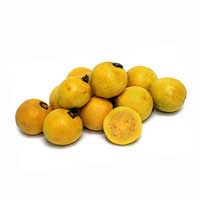Fruits Home
 Full List of Fruits
Full List of Fruits  Brazilian Guava
Brazilian Guava Brazilian Guava fruit
![]() Introduction of Brazilian Guava
Introduction of Brazilian Guava
Scientific name - Psidium guineenses
The Brazilian guava can be grown as both trees and shrubs. The shrubs measure about one to three meters and the trees reach about seven meters in height. The leaves have a toothed edge and have a blade like sharpness along the edges. They are about 14cm long and 8cm wide. The undersides reveal a granular surface with pale or reddish hairs. Fragrant flowers with a white corolla and several stamens can be found growing along the axils of the leaves either singly or in groups of three. The fruit is a firm yellowish, round fruit about 2.5cm wide. The flesh has two layers with the outer layer having a yellow color and the inner pulp white in color. The inner pulp is said to have tart strawberry flavor. Some describe it as bitter. Each species has a different taste and a few are sweet enough to be eaten raw. Crossing between this fruit and guava has been done, but has resulted in smaller fruits, numerous in numbers.
![]() Nutritional Value of Brazilian Guava
Nutritional Value of Brazilian Guava
Brazilian guava is an incredibly nutritious fruit, packed full of vitamins, minerals, and antioxidants. It is high in dietary fiber and contains vitamins A, B, and C, as well as potassium, magnesium, and iron. Guava is also a great source of lycopene, a powerful antioxidant that has been linked to many health benefits.
The health benefits of Brazilian guava are numerous. It can help lower cholesterol levels, reduce the risk of heart disease and stroke, and promote healthy blood sugar levels. It can also aid in digestion, boost the immune system, and help fight inflammation. Additionally, its high fiber content can help reduce hunger and cravings, making it a great addition to any weight-loss plan. Finally, guava has been linked to improved brain health, including improved cognitive performance and memory.
| Principle | Nutrient Value | Percentage of RDA |
|---|---|---|
| Energy | 68 Kcal | 3.5% |
| Carbohydrates | 14.3 g | 11.5% |
| Protein | 2.55 g | 5% |
| Total Fat | 0.95 g | 3% |
| Cholesterol | 0 mg | 0% |
| Dietary Fiber | 5.4 g | 14% |
| Vitamins | ||
| Folates | 49 µg | 12.5% |
| Niacin | 1.084 mg | 7% |
| Pantothenic acid | 0.451 mg | 9% |
| Pyridoxine | 0.110 mg | 8.5% |
| Riboflavin | 0.040 mg | 3% |
| Thiamin | 0.067 mg | 5.5% |
| Vitamin A | 624 IU | 21% |
| Vitamin C | 228 mg | 396% |
| Vitamin E | 0.73 mg | 5% |
| Vitamin K | 2.6 µg | 2% |
| Electrolytes | ||
| Sodium | 2 mg | 0% |
| Potassium | 417 mg | 9% |
| Minerals | ||
| Calcium | 18 mg | 2% |
| Copper | 0.230 mg | 2.5% |
| Iron | 0.26 mg | 3% |
| Magnesium | 22 mg | 5.5% |
| Manganese | 0.150 mg | 6.5% |
| Phosphorous | 11 mg | 2% |
| Selenium | 0.6 mcg | 1% |
| Zinc | 0.23 mg | 2% |
This pectin rich fruit is commonly used for baking and for preservation of Jelly’s. Another common way of consuming this fruit is by eating it raw, sliced or scooped. It can also be found in salads and fruit salads. Although it is a close relative of the guava, the flavor of the Brazilian guava sets itself apart from other regular guava flavors. A paste known as the goiabada is usually made from the pulp being cooked down and then mixed with sugar and water revealing a texture close to guava butter or leather.
![]() Health Benefits of Brazilian Guava
Health Benefits of Brazilian Guava
The barks of the tree or the roots are reduced to a decoction and are used to treat urinary infections, diarrhea and dysentery. In certain parts of Costa Rica, it is said to treat varicose veins and ulcers on the legs. A reduced decoction of the leaves is used to relieve colds and bronchitis.
1. High in Vitamin C: Brazilian guavas are a great source of vitamin C, with one guava providing almost twice the daily requirement. Vitamin C helps to boost the immune system and keep infection at bay.
2. Rich in Antioxidants: Brazilian guavas are rich in antioxidants, which helps to fight free radicals that can damage cells and cause diseases.
3. Control Blood Pressure: The minerals, potassium and magnesium, present in Brazilian guavas help to keep blood pressure in check.
4. Improve Digestion: The high fiber content of Brazilian guavas helps to regulate digestion and prevent constipation.
5. Improves Skin Health: The vitamin C and antioxidants present in Brazilian guavas help to keep skin healthy and glowing.
6. Helps Fight Diabetes: The fiber present in Brazilian guavas helps to slow down the digestion and absorption of sugar, which helps to control blood sugar levels.
Germination is pretty slow in the case of the Brazilian guava. It takes about 4 to 12 weeks and even longer. Usually germination is terminated midway due to the fluctuation in the temperature of the soil. A standard temperature of 75 to 85 ? F is preferable. Moderate amount of water and warm surrounding will ensure growth. A slight decrease in the temperature could hinder the growth and result in the death of the plant. The seeds are usually planted about a quarter to half inch deep in rich, fertile soil. Staggered germination is a common sight in the case of the Brazilian guava.



















